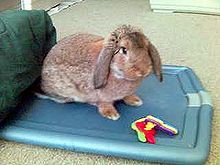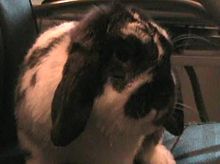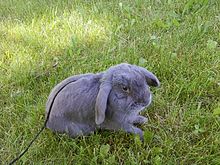- Mini Lop
-
 A chestnut Agouti Mini Lop
A chestnut Agouti Mini Lop
The Mini Lop is a very popular rabbit breed that is featured in numerous rabbit shows throughout the United States. In the USA, it is the third smallest Lop overall, the Holland lop and American fuzzy lops are smaller, as well as the smallest non-dwarfed lop. It is a different breed from the Holland Lop, which is the smallest (and only dwarf lop) of lop breeds in the USA. Its equivalent in the UK is the Dwarf Lop; however there is a breed called the Miniature Lop in that area, which is the equivalent of the Holland Lop in the United States.
Contents
History
Bob Herschbach discovered the Mini Lop breed at a German National Rabbit Show in Essen, Germany in 1972, where it was known as a Klein Widder. These first Mini Lops were originated from the German Big Lop and the small Chinchilla. These two breeds came originally in Agouti and white colors.
German lops were about 8 lb (3.6 kg), slender and large with thick ears. Herschbach, a Mini Lop promoter, achieved the first procreation of Mini Lops in the United States, mainly through breeding an agouti lop pair and a white female lop in 1972. Their first baby lops were solid colors. A second generation came with broken colors. As a result of the breeding process, they began to obtain a high standard of qualities Mini Lop.
In 1974, when Herschbach's Mini Lop rabbits made their debut in an American Rabbit Breeders' Association (ARBA) convention held in Ventura, California. The outcome was that the breed needed to be downsized to a more compact, attractive size. In order to achieve this, Herschbach enlisted the assistance of other breeders by letting them breed more of his Mini Lops. One final touch resulted in changing the breed name from Klein Widders to "Mini Lop" to make it more appealing to the public.
In 1977 the Mini Lop breed was under new sponsorship; Herb Dyke was the person in charge of this task.
In 1978, Herschbach and Dyke created a correspondence club for the Mini Lops. Within a year, they had over 500 members who had contacted the ARBA with support for the Mini Lop rabbit. In 1980, in Milwaukee, Wisconsin at the National Rabbit Convention, this breed marked its success when it was recognized as an official rabbit breed sanctioned by ARBA.
Shortly after, the Mini Lop Club of America was founded to promote it.[1]
Personality
Like any animal, Mini Lops come in a variety of personalities but, most often than not, they are fairly friendly and extremely playful. They are also very intelligent in that they can be trained a variety of tricks and commands and can be litter boxed trained.
They love to be with their family and will show their disapproval if neglected.
Showing Mini-Lops
The ideal Mini Lop is described as being a "basketball with a head". Judges like to see a nice rounded body with thick depth, long thick ears, a wide head and thick bone.
ARBA Accepted Colors
When showing Mini Lops the colors are broken down into two categories; Solids and Brokens. There are a many colors available in this breed however only certain colors are accepted. Some of these colors are:
Chinchilla, Chestnut Agouti, Lynx, Opal, Black, White, Ruby-Eyed White, Blue-Eyed White, Blue, Chocolate, Lilac, Orange, Opal, Black, Tri Color
Mini Lop Standard of Perfection
Schedule of points according to the ARBA Standard of Perfection:[2]
General Type 80
- Body 43
- Head 20
- Ears and crown 12
- Feet, Legs & Bone 5
Fur 10 Color & Markings 5 Condition 5
Weight Limits and showroom classes according to ARBA's Standard of Perfection:
- Senior Bucks- 6 months of age and older, weight 4½ lbs to 6½ lbs
- Senior Does- 6 months of age and older, weight 3 lbs to 6 lbs
- Junior Bucks and Does- Under 6 months, weight 3 lbs to 6 lbs
The Mini Lop rabbit is classified as a medium sized rabbit. Senior Bucks and Does must be six months of age and older and weigh no more than 6 1/2 lbs. Ideal weight is 5 1/2 lbs. Juniors Bucks and Does must be under six months of age and weigh less than 6 lbs. The various colors within a variety are not judged separately. They are divided for judging into two groups, classifications, solid and broken pattern.
General Type: When viewing the Mini Lop, one should see a rabbit that gives the general appearance of a massive, thick set, heavily muscled body. The animal should have a good balance of width and depth, allowing for a slight taper from the heavier hindquarters to the shoulders. There should be a good top line starting at the base of the skull and rising over the spine, with the peak over the center of the hips. The hips should be smooth, deep, well rounded and full in the lower hips. Faults: Long narrow body, chopped or undercut in the hips, and flat shoulders or hips.
Head: The head of the Mini Lop Rabbit should have strong and bold features. The head is to be set closely on the shoulders, with the neck as short as possible. The crown of the head is very boldly arched. There is a slight curvature of the skull from the base of the crown down towards the nose. The head should appear to be wide and have a well filled muzzle. The size of the head should balance with the body. Buck heads are usually wider than doe heads.
Faults: Long narrow head, pointed nose, concave or flat crown.
Ears: The ears of the Mini Lop carry as many points as the head. The ears should rise from a strong base ridge and then loop vertically on both sides of the head, thus giving a horseshoe appearance. The ears should lie close to the cheeks, with the ear openings turned toward the head. The ear length should he about 3/4 to 1 inch below the jaw and balance with the size of the animal. The ears should be well furred and rounded on the ends.
Faults: Poor ear carriage, folds in ear, extremely thin or thick ears, and ears turning away from the head.
Legs & Feet: Legs are important for good type. They should be straight, short, and thick. Toenail pigmentation can be either light or dark in the broken group. The front and rear nails may vary in color, but all front toenails must match and all rear toenails must match. Faults: Unmatched nails in broken colors.
Disqualifications: General toenail disqualifications apply on all solid pattern groups.
Fur: The Mini Lop fur is very thick and dense. It should be glossy and lustrous. It is medium in length with a good roll back.
Faults: Long, thin, silky, harsh or extremely short fur.
Color: Mini Lops come in many beautiful colors. When making a selection of stock, color really should be the last consideration before making your choice. Type should always be considered first. When judging, color points are divided equally between color and markings. The broken pattern includes any recognized color group in conjunction with white. A butterfly marking on the nose with wings outlined in white is preferred with colored eye circles and both ears colored. The body should have either a blanket or patched markings. Front feet should be white and rear feet may be white. Solid pattern includes any recognized color group.
Faults: Lacking complete head markings, light body markings, and excessive white hairs in a solid pattern.
Eyes: They may be any color, but must match each other.
Disqualifications: Eyes that do not match. Foreign color spots in rabbits of the solid pattern group. http://rockstarrabbits.webs.com/minilops.htm
See also
References
External links
- Mini lops - Mini lop information and training tips
- American Rabbit Breeder's Association
- Mini Lop Club of America
- For-Get-Me-Not Rabbitry
Categories:- Pet rabbits
- Lop rabbits
- Rabbit breeds originating in the United States
Wikimedia Foundation. 2010.



